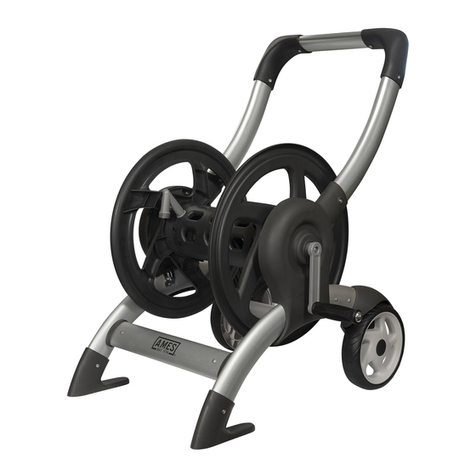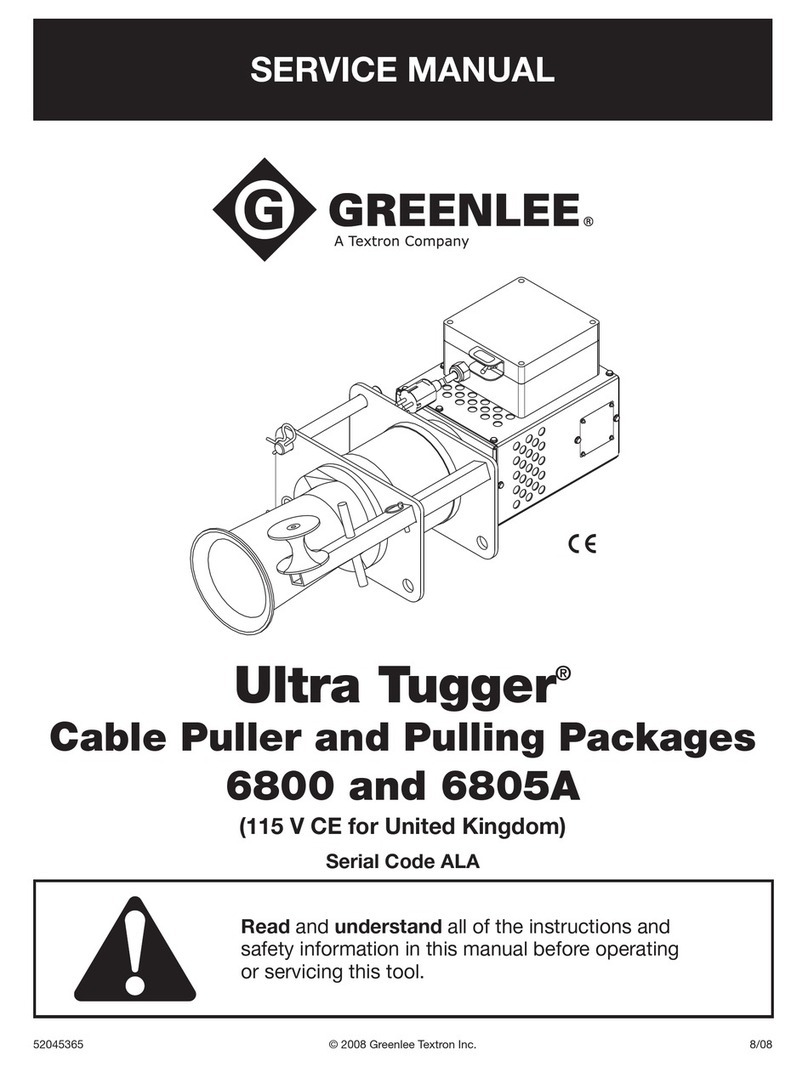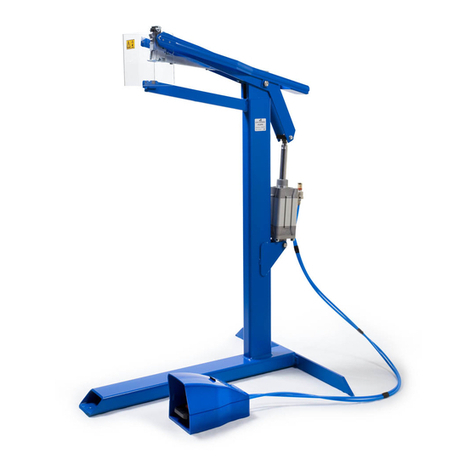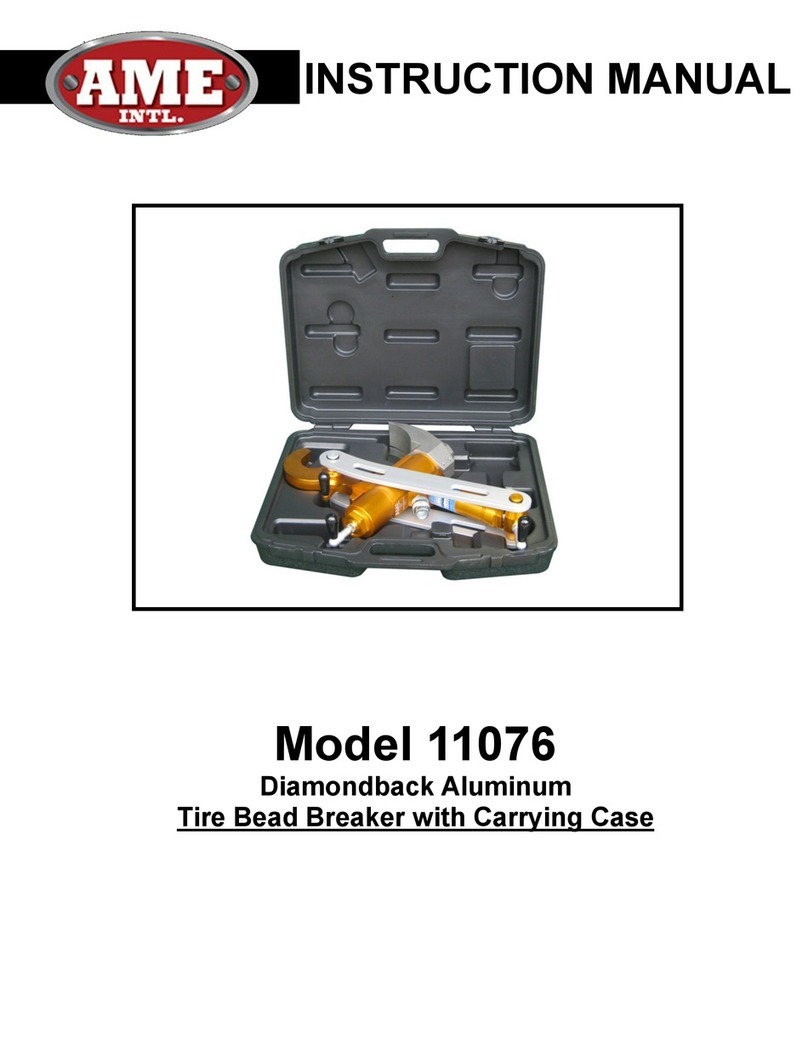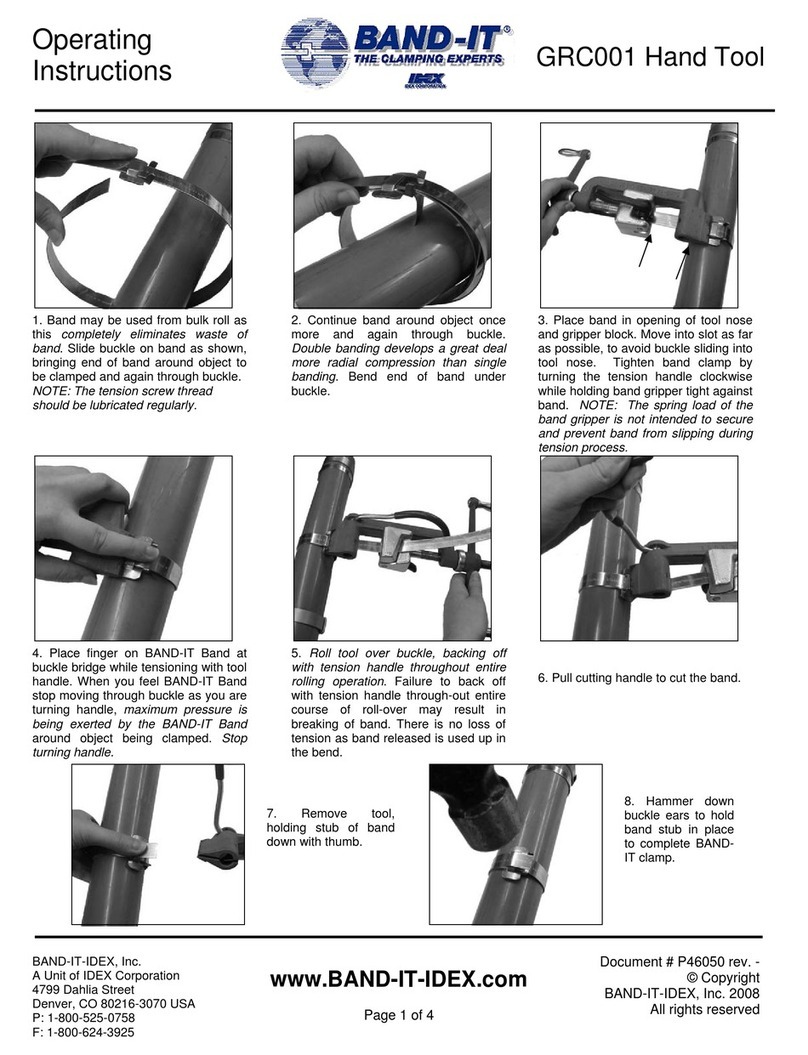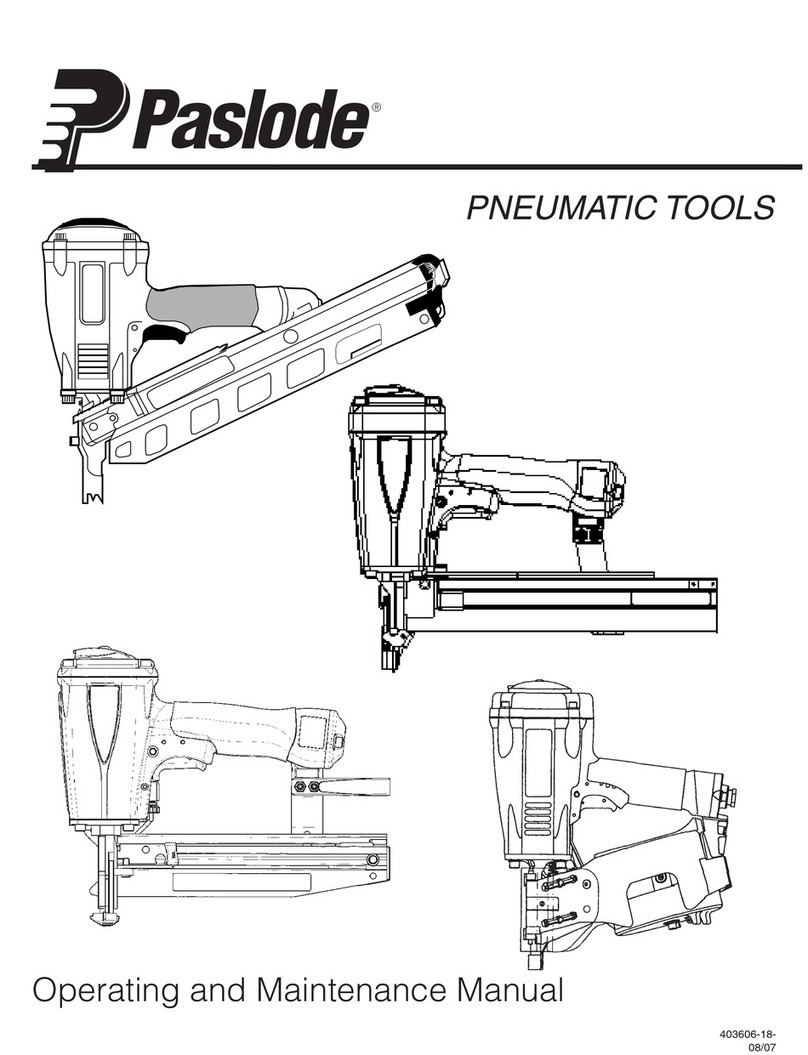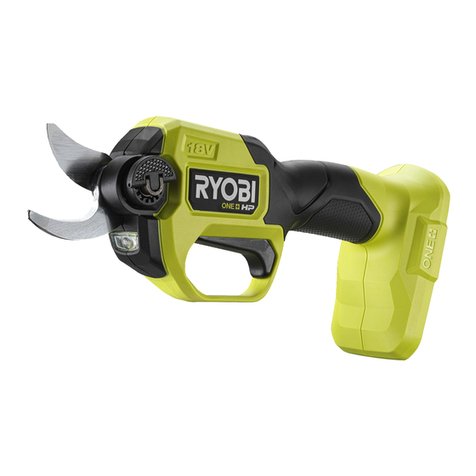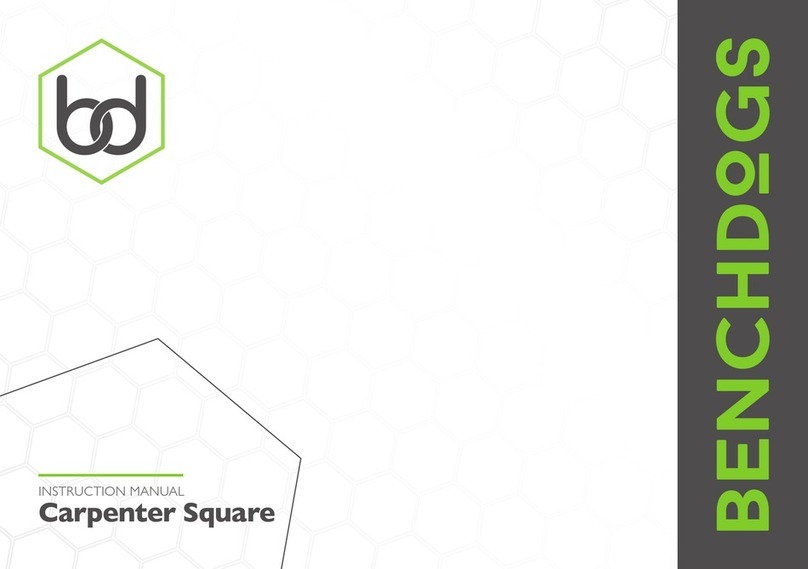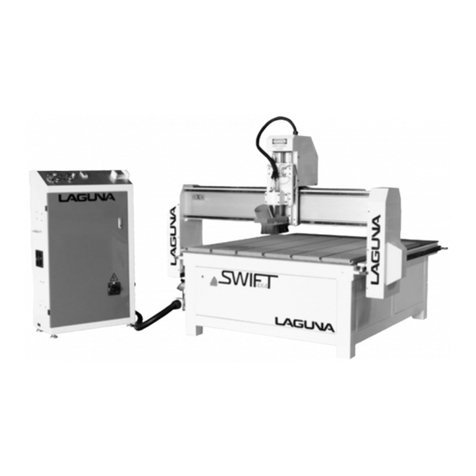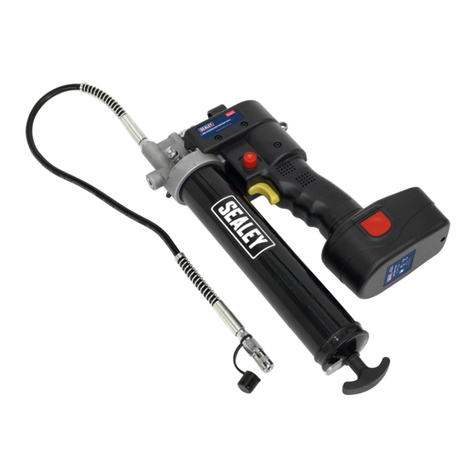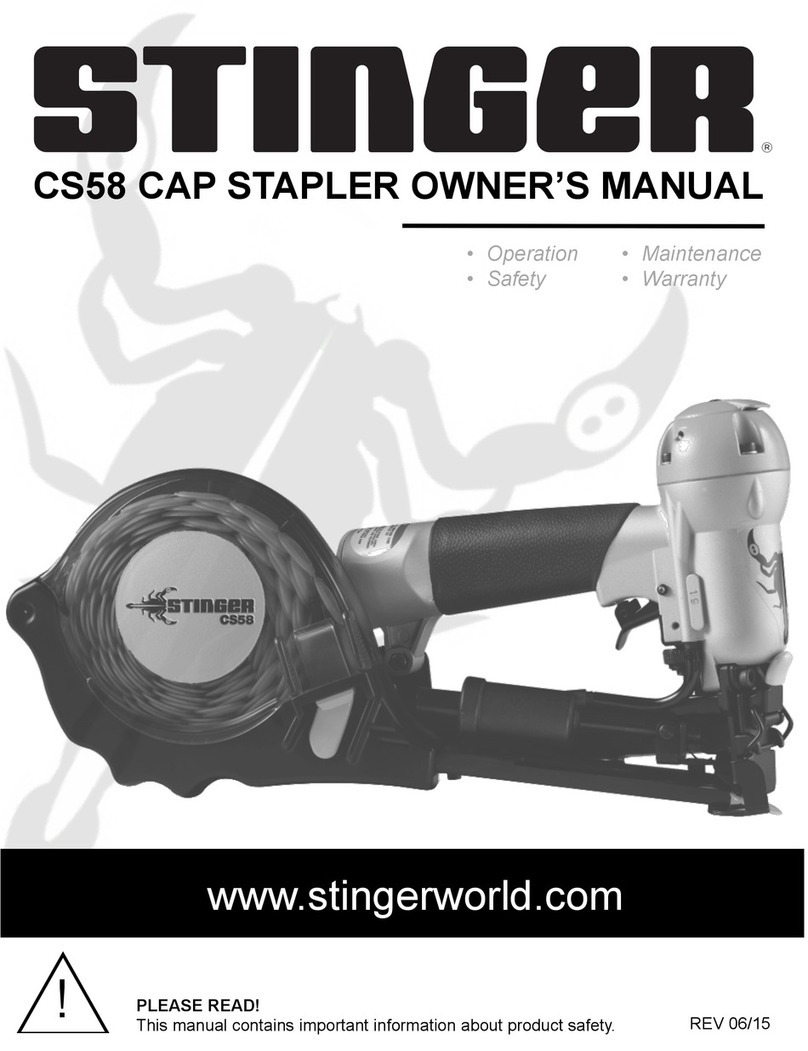Allmand ECLIPSE AB2400 User manual

Not for
Reproduction
Operator’s Manual
ECLIPSE®AB2400 Arrow Board
Manual del operador
ECLIPSE®Flecha de tránsito AB2400
Copyright © 2015 Briggs & Stratton Corporation
Milwaukee, WI, USA. All rights reserved.
Part No.: 106809
Revision: A
en
es

Not for
Reproduction
2www.allmand.com
Record Important Information
Recording the equipment information will help when placing
an order for replacement parts and/or decals.
Company Equipment No:____________________________
Unit model No:____________________________________
Unit Vin:_________________________________________
Engine Model No: ____________Serial No:_____________
Generator Model No:__________Serial No:_____________
Accessories:_____________________________________
_______________________________________________
_______________________________________________
Manual Contents:
Introduction ........................................................................2
Safety...................................................................................2
Features and Controls.......................................................7
Operation ............................................................................8
Maintenance .................................................................... 19
Troubleshooting .............................................................. 23
Specifications.................................................................. 23
Warranty........................................................................... 24
Introduction
About This Manual
TAKE TIME TO READ THIS MANUAL THOROUGHLY
This instruction manual provides necessary instructions for
the ECLIPSE®AB2400 Arrow Board.
The information found in this manual is in effect at the time
of printing. Allmand Bros Inc. may change contents without
notice and without incurring obligation.
Any reference in this manual to left or right shall be deter-
mined by looking at the trailer from the rear.
If you are uncertain about any of the information in the man-
ual, contact Allmand service department at 1-800-562-1373,
or contact us through the Allmand website, www.allmand.
com.
Save these original instructions for future reference.
Products Covered by This Manual
The following products are covered by this manual:
ECLIPSE®AB2400 ALT 15-Lamp Arrow Board
ECLIPSE®AB2400 APF 25-Lamp Arrow Board
Safety
Safety Definitions
Safety statements are one of the primary ways to call your
attention to potential hazards. Follow the precautions listed
throughout the manual before operation, during operation
and during periodic maintenance procedures for your safety,
the safety of others and to protect the performance of equip-
ment. Keep the decals from becoming dirty or torn and
replace them if they are lost or damaged. Also, if a part needs
to be replaced that has a decal attached to it, make sure to
order the new part and decal at the same time.
This safety alert symbol appears with most safety
statements. It means attention, become alert, your
safety is involved! Read and abide by the message
that follows the safety alert symbol.
DANGER
Indicates a hazardous situation which, if not avoided, will
result in death or serious injury.
WARNING
Indicates a hazardous situation which, if not avoided, could
result in death or serious injury.
CAUTION
Indicates a hazardous situation which, if not avoided, could
result in minor or serious injury.

Not for
Reproduction
3
en
NOTICE
Indicates a situation which can cause damage to the equip-
ment, personal property and/or the environment, or cause the
equipment to operate improperly.
NOTE:
Provides key information to make procedures easier or clear-
er.
Safety Precautions
The following section contains general safety precautions
and guidelines that must be followed to reduce risk to per-
sonal safety. Special safety precautions are listed in specific
procedures. Read and understand all of the safety precau-
tions before operating or performing repairs or maintenance.
DANGER
Electrocution Hazard
• Contact with overhead electrical wires will result in
death or serious injury. Always follow the rules or
instructions for your work site, and state, province or
national electric code for maintaining a safe distance
from overhead wires.
WARNING
Unsafe Operation Hazard
• Untrained personnel operating this equipment could
result in death or serious injury. Read and understand
the Operator’s Manual before operating or servicing
this equipment.
• Use of alcohol or drugs while operating or attempting
to operate this machine could result in death or seri-
ous injury. Never operate this machine while under
the influence of alcohol, drugs or when otherwise
impaired.
• Failure to replace safety decals or instructions that
have become damaged or torn could result in death
or serious injury. Always replace decals that are dam-
aged, torn or illegible.
WARNING
Fall Hazard
• Falling from moving equipment could result death or
serious injury. Never carry riders on this equipment.
WARNING
Modification Hazard
• Unauthorized modification of the equipment could
result in death or serious injury. Never modify the
equipment without consulting Allmand Brothers, Inc.
Service Department.
WARNING
Crush Hazard
• Standing or walking under elevated equipment could
result in death or serious injury. When elevating or
lifting the trailer, always keep clear of the area around
and under the trailer, and do not allow others in the
area.
WARNING
Exposure Hazard
• Failure to wear appropriate personal protective equip-
ment could result in death or serious injury. Always
wear personal protective equipment including appro-
priate clothes, gloves, work shoes, and eye and hear-
ing protection as required for the task.
WARNING
Rollover Hazard
• Raising the sign board without properly positioning the
outriggers first could cause machine rollover resulting
in death or serious injury. Always position the outrig-
gers on a smooth, flat and stable surface before rais-
ing the sign board.
• Attempting to move or lift the trailer with the sign board
raised could cause machine rollover resulting in death
or serious injury. Always lower the sign board to its
fully lowered position and lock in position with the
snapper pins before moving or lifting the trailer.
• Operating the arrow board trailer with the sign board
fully raised in winds exceeding 50 mph (80 km/h) can
cause machine rollover resulting in death or serious
injury. Always lower the sign board when winds are
expected to exceed 50 mph (80 km/h).

Not for
Reproduction
4www.allmand.com
WARNING
Explosion Hazard
• Smoking, open flame or other forms of ignition near
the battery could cause explosion resulting in death or
serious injury. Always keep smoking materials, open
flame and other forms of ignition away from the battery.
• Attempting to charge a frozen battery could cause
explosion resulting in death or serious injury. Always
be sure that the battery is not frozen, split open or
damaged before attempting to charge it.
WARNING
Entanglement / Sever Hazard
• Contact with moving or rotating parts of the machine
could cause death or serious injury. Always:
- Verify that all guards and covers are attached prop-
erly to the machine before operating.
- Remove jewelry, tie back long hair and keep hands,
other body parts and clothing away from moving or
rotating parts.
- Follow your companies “Lock Out, Tag Out” proce-
dure, or attach a “Do Not Operate” in a prominent
place on the machine prior to performing service or
maintenance on the machine.
WARNING
Control Hazard
• Underrated tow hitch could cause loss of control of the
towing vehicle or trailer resulting in death or serious
injury. Always:
- Ensure that the vehicle’s towing capacity exceeds
that of the trailer load.
- When using the trailer coupler, ensure that the
vehicle’s hitch and ball are rated to accept the trailer
load, and are the appropriate size for the trailer cou-
pler socket.
- When using the lunette eye, ensure that the vehicle’s
pintle hook is rated to accept the trailer load, and is
the appropriate size for the lunette eye.
• Dragging safety chains on the road surface could
cause them to fail in an emergency resulting in death
or serious injury. Always attach safety chains properly
and securely between the tow vehicle and the trailer,
and do not let them drag on pavement.
WARNING
Batteries give off explosive gases during recharging.
Sparks can cause explosions, reulting in death or
serious injury.
Batteries contain acid, which is extremely caustic.
Contact with battery contents will cause severe
chemical burns.
Batteries present a risk of electric shock and high
short circuit current.
• DO NOT dispose of battery in a fire. Recycle battery.
• DO NOT allow any open flame, spark, heat, or lit ciga-
rette during and for several minutes after charging a
battery.
• DO NOT open or mutilate battery.
• DO NOT charge a frozen battery.
• Wear protective gloves, rubber apron, rubber boots
and rubber gloves.
• Remove watches, rings, or other metal objects.
• Use tools having insulated handles.
WARNING
Flying Object Hazard
• Flying debris, pressurized steam or water and com-
pressed air could result in death or serious injury.
Always wear eye protection when working around or
cleaning the machine.
WARNING
California Proposition 65
• Certain components in this product and related
accessories contain chemicals known to the State
of California to cause cancer, birth defects, or other
reproductive harm. Wash hands after handling.
CAUTION
Slip Hazard
• Immediately clean up any spilled liquid on the shop
floor.
• Clean up accumulated dirt and debris on the shop
floor at the end of each shift.

Not for
Reproduction
5
en
NOTICE
The statements that follow have NOTICE level issues.
Damage to equipment or property can result if not fol-
lowed.
• Any part which is found defective as a result of inspection
or any part whose measured value does not satisfy the
standard or limit MUST be replaced.
• Always tighten components to the specified torque.
Loose parts can cause equipment damage or cause it to
operate improperly.
• Only use replacement parts specified. Other replacement
parts may effect warranty coverage.
• Clean all accumulated dirt and debris away from the
body of the equipment and its components before you
inspect the equipment or perform preventative mainte-
nance procedures or repairs. Operating equipment with
accumulated dirt and debris will cause premature wear of
equipment components.
• Never dispose of hazardous materials by dumping them
into a sewer, on the ground, or into groundwater or water-
ways.
• Retrieve any tools or parts that may have dropped inside
of the equipment to avoid improper equipment operation.
• If any alert indicator illuminates during equipment opera-
tion, stop operation immediately. Determine the cause
and repair the problem before continuing to operate the
equipment.
Safety Decals
Before operating your unit, read and understand the following
safety decals. Compare Figure 1 with the table below. The
cautions, warnings, and instructions are for your safety. To
avoid personal injury or damage to the unit, understand and
follow all the decals.
WARNING
If any safety or instructional decals become worn or dam-
aged, and cannot be read, order replacement decals from
your dealer.
Figure 1
E
F
K
G
H
I
KL
J
B
A
C
C
D
D
Domestic Models
A WARNING - Hood Latch.
Failure to turn hood
latch in block position
while hood is open could
result in death or serious
injury. Always turn hood
latch in block position
after opening hood.
Part No. 107245
B WARNING - Explosion
Hazard. Smoking mate-
rials, open flames, or
other forms of ignition
near the battery could
cause explosion result-
ing in death or serious
injury. Always keep
smoking materials, open
flames, and other forms
of ignition away from the
battery.
Part No. 106940

Not for
Reproduction
6www.allmand.com
International Models
A WARNING - Hood
Latch. Failure to turn
hood latch in block
position while hood is
open could result in
death or serious injury.
Always turn hood latch
in block position after
opening hood.
Part No. 107535
107535
C WARNING - Locking
Sign Board. Failure to
lock the sign board in
the upright (operating)
position before opera-
tion could result in death
or serious injury. Always
lock the sign board in
the upright (operationg)
position before machine
operation.
Part No. 106939
DTie-Down Point
Part No. 104753
E DANGER - Contacting
Power Lines. Contacting
electric power lines
when raising the sign
board will result in death
or serious injury. Always
maintain a safe distance
from power lines when
raising the sign board.
Part No. 090008
F CAUTION - Icy
Conditions. Snow and
ice could cause uncon-
trolled condition in winch
that could result in minor
or moderate injury.
Always check to make
sure pawl engages gear,
and apply silicone to
winch as needed.
Part No. 106941
G WARNING - Excessive
Towing Speed. To pre-
vent death, serious injury
or equipment damage,
do not exceed 55 mph
(90 km/h).
Part No. 090160
H WARNING - Locking
Sign Board. Failure to
lock the sign board in the
lowered (transport) posi-
tion could result in death
or serious injury. Always
lock the sign board in
the lowered (transport)
position before towing
the trailer.
Part No. 090079
INo Step
Part No. 090147
JOperating Instructions
Part No. 107244 1 2 3
1 2 3
1 2 3
4
4 5
5
107244
0°±2.8°
K WARNING - Positioning
Jack Stands
(Outriggers). Raising
the sign board without
properly positioning the
jack stands could result
in death or serious injury.
Always position the jack
stands on a smooth,
flat and stable surface
before raising the sign
board.
Part No. 090125
L WARNING - Read
Manual. Read and
understand the
Operator’s Manual
before attempting to
operate the machine.
Part No. 090148

Not for
Reproduction
7
en
Features and Controls
Introduction
Allmand Eclipse®2400 Series arrow board trailers meet
the U.S. Department of Transportation (USDOT), Federal
Highway Administration (FHA) requirements as stated in
B WARNING - Explosion
Hazard. Smoking mate-
rials, open flames, or
other forms of ignition
near the battery could
cause explosion result-
ing in death or serious
injury. Always keep
smoking materials,
open flames, and other
forms of ignition away
from the battery.
Part No. 107536
107536
C WARNING - Locking
Sign Board. Failure to
lock the sign board in
the upright (operat-
ing) position before
operation could result in
death or serious injury.
Always lock the sign
board in the upright
(operationg) position
before machine opera-
tion.
Part No. 107531
107531
DTie-Down Point
Part No. 104753
E DANGER - Contacting
Power Lines. Contacting
electric power lines
when raising the sign
board will result in
death or serious injury.
Always maintain a safe
distance from power
lines when raising the
sign board.
Part No. 107530
107530
F CAUTION - Icy
Conditions. Snow and
ice could cause uncon-
trolled condition in
winch that could result
in minor or moderate
injury. Always check
to make sure pawl
engages gear, and
apply silicone to winch
as needed.
Part No. 107532
107532
G,H WARNING - Excessive
Towing Speed. To pre-
vent death, serious
injury or equipment
damage, do not exceed
55 mph (90 km/h).
WARNING - Locking
Sign Board. Failure to
lock the sign board in
the lowered (transport)
position could result in
death or serious injury.
Always lock the sign
board in the lowered
(transport) position
before towing the trailer.
Part No. 107533
107533
≤90 km/h (55 mph)
INo Step
Part No. 107522
JOperating Instructions
Part No. 107244 1 2 3
1 2 3
1 2 3
4
4 5
5
107244
0°±2.8°
K WARNING - Positioning
Jack Stands
(Outriggers). Raising
the sign board without
properly positioning the
jack stands could result
in death or serious
injury. Always position
the jack stands on a
smooth, flat and stable
surface before raising
the sign board.
Part No. 107534
107534
L WARNING - Read
Manual. Read and
understand the
Operator’s Manual
before attempting to
operate the machine.
Part No. 105508

Not for
Reproduction
8www.allmand.com
the Manual on Uniform Traffic Control Devices (MUTCD).
They are intended for use as a stationary roadside device to
advise approaching traffic of lane closure along multi-lane
roadways. Allmand Eclipse 2400 Series arrow boards con-
form to MUTCD Type ‘C’ (minimum sign board size 96 x 48
inches / 244 x 122 cm) requirements for high-speed, high
volume motor vehicle traffic control projects.
The Allmand Eclipse 2400 Series arrow board is powered by
a 12 volt DC battery which is charged by a photovoltaic solar
panel. The combination of the battery and solar panel allow
maintenance-free operation for long periods of time.
Identify the features and controls of the machine by compar-
ing Figure 2 with the table below. See “Operation” for detailed
information on each feature / control.
Figure 2
L
M
O
N
P
C
D
B
A
E
G
F
H
J
K
I
Ref Description
ALamp Assembly (15 or 25, depending on model)
BSolar Panel
CSign Board (in transport position)
DSign Board Controller (partially hidden)
ESign Board Hoisting Cable
FTongue Jack
GCombination Trailer Coupler / Lunette Eye
HSafety Chains (2)
IBattery
JOutrigger (4)
KTrailer Positioning Eyelet (2)
LBattery Compartment Door (shown open)
MLicense Plate Bracket / Lamp
NTaillight (2)
OWheel Assembly (2)
PWinch
Operation
See “Safety” before attempting to operate the unit.
Preparing the Arrow Board for Use
If the arrow board has been stored or idle for a period of time,
follow these steps to prepare the Eclipse 2400 Series arrow
board trailer for use.
WARNING
Unsafe Operation Hazard
• Operating or towing a machine with worn, damaged
or missing parts can result in death or serious injury.
Always replace worn, damaged or missing parts
promptly. Do not operate or tow this machine until all
worn, damaged or missing parts have been replaced,
and proper operation of machine has been verified.
NOTICE
The replacement of any part on this machine by anything
other than an Allmand authorized replacement part may
adversely affect the performance, durability or safety of this
machine and may void the warranty. Allmand assumes no
liability for unauthorized replacement parts which adversely
affect the performance, durability or safety of this machine.
Pre-Operation Check List
1. Check that a copy of the Operator’s Manual is with the
arrow board trailer in the manual storage container.
2. Check that all safety decals are legible and in place on
the arrow board trailer. See “Location of Safety Decals”
in the Operator Safety section of this manual.

Not for
Reproduction
9
en
3. Check the arrow board trailer for proper operation:
a. Check that the outriggers operate properly, and that
each one is locked with the correct snapper pin. See
“Setting the Outriggers”.
b. Check the winch and cable system for proper opera-
tion. Make sure the cable is not frayed or damaged.
c. Check that the sign board can be positioned properly,
and that it can be locked in both the transport and
operating positions. Check that the correct snapper
pins for locking the sign board in position are with the
trailer. See “Raising and Lowering the Sign Board”.
d. Check that the trailer coupler operates properly, and
that the combination trailer coupler / lunette eye is
securely fastened to the arrow board trailer tongue.
See “Connecting the Trailer to the Tow Vehicle” for
detailed information on operating the trailer coupler /
lunette eye.
e. Check that the safety chains are properly secured to
the arrow board trailer tongue, and check the safety
chains and hooks for damage. Replace damaged
safety chains and hooks.
f. Check the condition and inflation pressure of the tires.
See “Checking the Tire Pressure” in the Maintenance
section.
WARNING
Unsafe Operation Hazard
• Towing a trailer with worn, damaged or underinflated
tires could result in death or serious injury. Always
replace worn or damaged tires promptly. Always keep
tires inflated to proper cold tire inflation pressure.
4. Check the battery for adequate charge. Charge if need-
ed. See “Maintaining the Battery” in the Maintenance
section.
5. If the trailer was stored with the battery disconnected,
reconnect the battery. See “Maintaining the Battery” in
the Maintenance section.
6. Make sure that the solar panel is clean and free of dirt
and debris that could hamper adequate charging of the
battery. See “Cleaning” in the Maintenance section.
7. Check that all modes of the sign board lighting system
are working properly. See “Operating the Sign Board”.
Preparing The Arrow Board For Towing
To prepare the Eclipse 2400 Series arrow board trailer for
towing:
1. Check the tow vehicle’s owner / operator manual for the
maximum towing capacity. Make sure the tow vehicle
and trailer hitch are rated to tow the arrow board trailer.
See “Specifications” for detailed information on trailer
weight and tongue weight.
WARNING
Unsafe Operation Hazard
• Towing a trailer with an underrated tow vehicle, or an
underrated or undersized hitch could result in death
or serious injury. Always use a tow vehicle that has a
rated towing capacity that exceeds the Gross Vehicle
Weight Rating (GVWR) of the trailer, and is equipped
with the appropriate size tow hitch rated for the GVWR
of the trailer.
2. Check the tow vehicle’s lighting connector and make
sure it will mate with the trailer lighting connector on the
arrow board trailer.
3. The arrow board trailer is equipped with both a SAE
J684 Class 2 trailer coupler (for use with a 2 inch (50
mm) diameter ball), and a SAE J847 lunette eye (3 inch
(75 mm) diameter) for a pintle hook. Determine which
is to be used for towing the trailer. See “Trailer Coupler
And Lunette Eye” for detailed information on changing
between the trailer coupler and the lunette eye.
WARNING
Unsafe Operation Hazard
• Failure to secure the combination trailer coupler and
lunette eye to the trailer tongue could cause the trailer
to separate from the tow vehicle, resulting in death or
serious injury. Always check and securely tighten the
hardware securing the combination trailer coupler and
lunette eye to the tongue.
4. Check that the safety chains are properly secured to the
arrow board trailer tongue, and check the safety chains
and hooks for damage. Replace damaged safety chains
and hooks.
5. Check the condition and inflation pressure of the tires.
See “Checking the Tire Pressure”.
WARNING
Unsafe Operation Hazard
• Towing a trailer with worn, damaged or underinflated
tires could result in death or serious injury. Always
replace worn or damaged tires promptly. Always keep
tires inflated to proper cold tire inflation pressure.
6. If the sign board is not already lowered to the transport
(horizontal) position, lower the sign board. See “Raising
and Lowering the Sign Board”.
7. Make sure that the sign board is locked in the transport
position. See “Raising and Lowering the Sign Board”.

Not for
Reproduction
10 www.allmand.com
WARNING
Unsafe Operation Hazard
• Failure to lock the sign board in the transport (horizon-
tal) position before transporting could result in death
or serious injury. Always lock the sign board in the
transport position before transporting the arrow board
trailer.
8. Close the sign board controller cover on the bottom right
edge of the sign board. See “Operating the Sign Board”.
9. Make sure the battery compartment door is closed and
secured with the cotter pin. See “Maintaining the Battery”
in the Maintenance section.
10.Raise and lock the outriggers in the transport position.
See “Setting the Outriggers”.
NOTE: Make sure the tongue jack is supporting the trailer
before raising the outriggers.
WARNING
Rollover Hazard
• Failure to support the trailer tongue with the tongue
jack before raising the outriggers could result in death
or serious injury. Always support the trailer tongue with
the tongue jack before raising the outriggers
WARNING
Unsafe Operation Hazard
• Failure to raise and lock the outriggers in the transport
position could result in death or serious injury. Always
raise and lock the outriggers in the transport position
before transporting the arrow board trailer.
11.Connect the trailer coupler or lunette eye to the tow vehi-
cle trailer hitch or pintle hook. Connect the safety chains
and trailer lighting connector to the tow vehicle. See
“Connecting The Trailer To The Tow Vehicle”.
Combination Trailer Coupler And
Lunette Eye
Eclipse 2400 Series arrow board trailers are equipped with
an adjustable height, reversible combination trailer coupler
and lunette eye. The trailer coupler is a SAE J684 Class 2
tow hitch for use with a 2 inch (50 mm) diameter ball. The
lunette eye is 3 inches (75 mm) in diameter conforming to the
requirements of SAE J847.
WARNING
Unsafe Operation Hazard
• Operating or towing a machine with worn, damaged
or missing parts can result in death or serious injury.
Always replace worn, damaged or missing parts
promptly. Do not operate or tow this machine until all
worn, damaged or missing parts have been replaced,
and proper operation of machine has been verified.
1. Check the tongue, trailer coupler and lunette eye for
missing and damaged parts. Replace any part that is
missing or damaged.
2. To change the position of the trailer coupler and the
lunette eye, remove the two hex head screws and lock
nuts (A, Figure 3) securing the channel portion of the
lunette eye to the tongue. Discard the lock nuts. Do
not remove the two hex head screws and lock nuts (B)
securing the trailer coupler to the lunette eye.
3. Select the trailer coupler (C, Figure 3) or lunette eye (D)
(whichever is required to couple the arrow board trailer to
the tow vehicle), and position it at the front of the tongue.
Determine the height which works best for the tow vehi-
cle.
4. Insert the two hex head screws removed in Step 2
through the appropriate holes in the tongue and through
the holes in the channel on the lunette eye.
5. Using new lock nuts, install nuts on the two hex head
screws and tighten securely.
6. Check the two hex head screws and lock nuts securing
the trailer coupler to the channel of the lunette eye, and
make sure they are tight. If the screws or lock nuts are
loose, replace the lock nuts and tighten securely.
WARNING
Unsafe Operation Hazard
• Failure to secure the combination trailer coupler and
lunette eye to the trailer tongue could cause the trailer
to separate from the tow vehicle, resulting in death or
serious injury. Always check and securely tighten the
hardware securing the combination trailer coupler and
lunette eye to the tongue.

Not for
Reproduction
11
en
Figure 3
D
A
B
C
Connecting The Trailer To The Tow
Vehicle
To connect the Eclipse 2400 Series arrow board trailer to the
tow vehicle.
1. Place wheel chocks on both sides of each of the arrow
board trailer wheels.
2. Use the tongue jack to raise the trailer coupler or lunette
eye above the tow vehicle’s hitch ball or pintle hook. Turn
the jack handle clockwise to raise the trailer tongue.
3. Position the tow vehicle’s hitch ball or pintle hook under
the trailer coupler or lunette eye.
4. Lower the trailer coupler or lunette eye onto the hitch
ball or pintle hook using the tongue jack. Turn the jack
handle counter-clockwise to lower the tongue jack.
5. Lock the trailer coupler or pintle hook. See “Using The
Trailer Coupler” or “Using A Pintle Hook” for detailed cou-
pling information.
6. Attach the safety chains (A, Figure 4) to the tow vehicle’s
hitch frame. Cross the chains under the tongue as
shown in Figure 4. Leave enough slack in the chains to
allow for turns, but not so much that the chains will con-
tact the road surface.
WARNING
Control Hazard
• Attach the safety chains properly and securely
between the towing vehicle and trailer before towing.
• Never allow the safety chains to drag the ground when
towing.
7. Connect the trailer lighting connector (B, Figure 4) to the
tow vehicle’s connector. Make sure that the trailer light-
ing harness has adequate length to prevent disconnec-
tion when turning, but not so much length that the har-
ness will contact the road surface. Check the stop, turn
signal, tail, side maker and license plate lamps for proper
operation.
Figure 4
A
B
8. Turn the tongue jack handle (A, Figure 5) counter-clock-
wise to fully retract the tongue jack (B). Fold the crank
handle over completely to lock the crank handle in trans-
port position (C). Pull the lock lever (D) and rotate the
jack 90° to place the jack in transport position (E), and
release the lock lever. Make sure the lock lever engages
and is secure.
Figure 5
A
B
D
E
C
9. Remove the wheel chocks from both sides of each of the
arrow board trailer wheels.
Using The Trailer Coupler
Eclipse 2400 Series arrow board trailers are provided with
an SAE Class 2 trailer coupler for gross trailer weights up to
3,500 pounds (1,589 kg), and maximum tongue weights of

Not for
Reproduction
12 www.allmand.com
300 pounds (136 kg). This coupler complies with SAE J684
and VESC V-5 standards.
To couple the trailer to the tow vehicle:
1. Pull the locking trigger (A, Figure 6) upward and lift the
locking lever (B, shown lifted).
2. Adjust the coupler to the hitch ball (F, Figure 6) by push-
ing the channel lock (D) up, away from the adjusting nut
(E).
3. Tighten the adjusting nut by turning the nut clockwise,
or loosen by turning counter-clockwise. Proper adjust-
ment is obtained when the coupler is as tight as possible
on the ball and the locking lever can still be opened and
closed.
NOTE: Check adjustment frequently and tighten the
adjusting nut as necessary.
4. Make sure the hitch ball is completely engaged in the
coupler socket (C, Figure 6).
5. Push the locking lever down into the locked position.
Insert the locking pin (G, Figure 6) into the hole in the
locking lever, or use a padlock for added security.
6. Check that the coupler is securely attached to the ball
hitch.
To uncouple the trailer from the tow vehicle:
1. Remove the locking pin (or padlock, if used) from the
hole in the locking lever.
2. Pull the locking trigger upward and lift the locking lever.
Figure 6
B
A
F
G
E
D
C
Using A Pintle Hook
The lunette eye meets the requirements of SAE J847, and
is 3 inches (75 mm) in diameter. Couple the lunette eye to a
pintle hook meeting the requirements of SAE J847.
When using the lunette eye with a pintle hook, follow the pin-
tle hook manufacturer’s instructions for coupling and locking
the lunette eye to the pintle hook, and uncoupling the lunette
eye from the pintle hook.
Figure 7 shows a typical pintle hook.
Figure 7
Towing The Arrow Board
The rated maximum highway towing speed for the Eclipse
2400 Series arrow board trailers is 55 MPH (90 km/h). Be
sure to check state or province laws regarding maximum
legal towing speeds for trailers.
WARNING
Excessive Speed Hazard
• Excessive speed when towing the trailer could result in
death or serious injury. Always maintain a safe towing
speed for road conditions. Never exceed 55 MPH (90
km/h) when towing the trailer.
When towing the arrow board trailer off-highway or on rough-
er terrain, the maximum towing speed is 20 MPH (30 km/h).
Eclipse 2400 Series arrow board trailers are designed to be
towed with the sign board in the transport position only. See
“Raising and Lowering the Sign Board”.
WARNING
Towing Hazard
• Failure to secure all trailer components in the transport
position before towng could result in death or seri-
ous injury. Always secure all trailer components in the
transport position before towing.
Eclipse 2400 Series arrow board trailers are SAE Class 1
trailers (gross trailer weights up to 2,000 pounds / 907 kg,
and maximum tongue weights of 200 pounds / 91 kg). They
are not required to be equipped with an axle brake system or
a break-away brake system.
If intending to tow the arrow board trailer to the work site with
added ballast or weight, do not exceed the maximum weight
limits for trailers without axle brake or break-away brake sys-
tems. Check state or province laws regarding maximum legal
weights for trailers without axle brake or break-away brake
systems.

Not for
Reproduction
13
en
Work Site Considerations
Prior to setting up the Eclipse 2400 Series arrow board trailer,
the operator must determine where to place it on the work
site. Consideration must be given to ground conditions, over-
head clearance, wind, and sign board visibility.
It is the operator’s responsibility to ensure that the arrow
board trailer is properly and safely positioned at the work site.
Follow state, province and federal rules, as well as rules or
instructions for the work site.
Ground Conditions
WARNING
Rollover Hazard
• Positioning the arrow board trailer on soft or unstable
ground could cause trailer rollover resulting in death
or serious injury. Always position the trailer on a firm,
level and stable surface and deploy the outriggers
before raising the sign board.
The arrow board trailer must be placed on a firm, stable
surface that will support the total weight of the trailer, and
support the force exerted on the ground by each of the four
outriggers as well as the tongue jack. Make sure the surface
has enough area to allow full extension of all outriggers and
the tongue jack. The surface should be level, and must not
exceed a grade of 5% (2.8° incline) in any direction. Grades
greater than 5% may exceed the extension limits of the out-
riggers and prevent the trailer from being properly leveled.
Overhead Clearance
DANGER
Electricution Hazard
• Contact with overhead electrical wires will result in
death or serious injury. Always follow the rules or
instructions for your work site, and the state, province
and federal rules for maintaining a safe distance from
overhead wires.
Make sure there are no overhead obstructions in the area
where the arrow board trailer is to be placed, keeping in mind
the total height of the arrow board trailer with the sign board
in the operating (vertical) position. See “Specifications”.
Always keep well clear of overhead electrical wires. Also
keep clear of loose cables, ropes or obstructions that could
ensnare the sign board.
When in the operating position, the solar panel should be
exposed to sunlight for the majority of daylight hours. The
solar panel requires adequate sunlight to maintain battery
charge, and should not be in shady areas.
Wind
WARNING
Unsafe Operation Hazard
• Operating the arrow board trailer with the sign board
in the operating position in winds exceeding 50 mph
(80 km/h) can cause trailer tip over resulting in death
or serious injury. Always lower the sign board when
winds are expected to exceed 50 mph (80 km/h).
When positioned on level, stable ground with the outriggers
deployed and the sign board raised in the operating (verti-
cal) position, the arrow board trailer is designed to withstand
sustained winds of 50 MPH (80 km/h) without tip over. This
does not include the addition of wind generated by passing
vehicles.
When placing the trailer on the work site, be aware of ground
obstructions such as structures or trees that may direct wind
toward or cause buffeting around the arrow board trailer.
As noted, wind generated by passing vehicles will also affect
the arrow board trailer. Position the trailer with sufficient dis-
tance from traffic lanes to minimize the effect of wind gener-
ated by passing vehicles.
Visibility
The arrow board should be visible to oncoming traffic at
least 1 mile (1.6 km) away. Be aware of ground obstruc-
tions that may block visibility, such as structures or trees.
Consideration should also be given to intersections, on and
off ramps, and other diverting lanes or roadways. Also be
aware of the curvature of the roadway approaching the arrow
board.
Always confirm the visibility of the arrow board by observing it
from various vantage points on the roadway approaching the
arrow board.
Use the eyelets to assist in positioning the arrow board. See
“Using the Eyelets to Position the Trailer”.
Using The Eyelets To Position The
Trailer
The eyelets located midway up the left side frame uprights
(as viewed from the rear of the arrow board) are used to sight
through to assist in positioning the arrow board at the work
site.
1. Position yourself at the front (tongue end) of the arrow
board trailer, facing oncoming traffic.
2. Locate a point on the roadway (A, Figure 8) approximate-
ly 1 mile (1.6 km) (B) from the arrow board in approach-
ing traffic.
3. Sight through both eyelets (C, Figure 8) and determine
where the point in approaching traffic is relative to the
eyelets.

Not for
Reproduction
14 www.allmand.com
4. Use the tow vehicle to move the arrow board trailer left
or right until the point is on a vertical line either above or
below the eyelets.
5. Once side-to-side positioning is achieved, disconnect the
trailer from the tow vehicle. See “Disconnecting the Trailer
from the Tow Vehicle”.
6. Use the outriggers to move the arrow board trailer up or
down until the point is in the center of the eyelets. See
“Setting the Outriggers”.
7. Check the visibility of the arrow board by observing it
from various vantage points on the roadway approaching
the arrow board. Adjust as needed.
Figure 8
B
A
C
Disconnecting The Trailer From The Tow
Vehicle
1. Make sure the selected work site is suitable for the arrow
board trailer. See “Work Site Considerations”.
2. Position the arrow board trailer to face oncoming traffic.
See “Using The Eyelets To Position The Trailer”.
3. Chock both sides of each wheel.
WARNING
Crush Hazard
• Attempting to move or position the arrow board trailer
by manually pushing or pulling it could present a crush
hazard resulting in death or serious injury. Always
position the trailer with the tow vehicle, chock the
wheels and lower the tongue jack before uncoupling
the trailer from the tow vehicle.
4. Disconnect the trailer lighting connector from the tow
vehicle’s connector.
5. Pull the lock lever (A, Figure 9) and rotate the tongue
jack 90° so that the pad of the jack faces the ground
(B), and release the lock lever. Make sure the lock lever
engages the locking hole and is secure. Unfold the crank
handle (C) to unlock and operate the jack. Turn the
tongue jack handle clockwise (D) to extend the tongue
jack (E), and support the trailer to allow the trailer coupler
or pintle hook to be disconnected from the tow vehicle.
Figure 9
D
E
A
B
C
5. Disconnect the trailer coupler or pintle hook. See “Using
The Trailer Coupler” or “Using A Pintle Hook” for detailed
uncoupling information.
6. Use the tongue jack to raise the trailer coupler or lunette
eye above the tow vehicle’s hitch ball or pintle hook.
7. Disconnect the safety chains from the tow vehicle’s hitch
frame.
8. Move the tow vehicle clear of the arrow board trailer.

Not for
Reproduction
15
en
Setting The Outriggers
WARNING
Rollover Hazard
• Raising the sign board without properly positioning
the outriggers could cause trailer rollover, resulting in
death or serious injury. Always extend the outriggers
on a firm, level, and stable surface before raising the
sign board.
1. Make sure the work site is suitable for the arrow board
trailer. See “Work Site Considerations”.
2. Position the arrow board trailer to face oncoming traffic.
See “Using The Eyelets To Position The Trailer”.
3. Disconnect the arrow board trailer from the tow vehicle.
See “Disconnecting the Trailer from the Tow Vehicle”.
4. Level the arrow board trailer using the tongue jack:
• Turn the jack handle clockwise to raise the front of
the trailer.
• Turn the jack handle counterclockwise to lower the
front of the trailer.
NOTE: A jack may be required to level the trailer side-to-
side.
5. Lower the front of the trailer using the tongue jack (A,
Figure 10).
6. Set the rear outriggers (B, Figure 10) by unlocking (F,
inset) and removing (G) the locking pin securing each
outrigger to the trailer frame. Slide the outrigger down
until the top of the outrigger is flush with the top of the
outrigger bracket on the frame (H). Secure with the lock-
ing pin.
7. Raise the front of the trailer using the tongue jack (C,
Figure 10).
8. Set the front outriggers (D, Figure 10). (Follow the same
procedure as in Step 6.)
9. Fully raise the tongue jack. The trailer should now rest
solely on the outriggers, with the tires raised off the
ground approximately 3” (7,6 cm) (E, Figure 10).
Figure 10
AB
C
DE
F
G
H
Raising And Lowering The Sign Board
WARNING
Rollover Hazard
• Raising the sign board without properly positioning
the outriggers could cause trailer rollover, resulting in
death or serious injury. Always extend the outriggers
on a firm, level, and stable surface before raising the
sign board.
To raise the sign board:
1. Remove the locking pins (A, Figure 11) securing the sign
board in the transport position (B).
2. Turn the winch handle clockwise (C, Figure 11) until the
sign board is in the operating (vertical) position (D).

Not for
Reproduction
16 www.allmand.com
NOTICE
Do not overturn the winch handle. Equipment damage can
result.
3. Secure the sign board in the operating position with the
locking pins removed in Step 1.
WARNING
Unsafe Operation Hazard
• Failure to lock the sign board in the operating position
could result in death or serious injury. Always lock the
sign board in the operating position at all times during
operation.
.50
Figure 11
A
C
D
B
To lower the sign board:
1. Remove the locking pins securing the sign board in the
operating position.
2. Turn the winch handle counterclockwise 2 rotations to
begin lowering the sign board. If the sign board begins to
lower, proceed to Step 7; if not, proceed to Step 3.
3. If the sign board does not begin to lower, turn the winch
handle clockwise 2 rotations, or until the cable is tight.
4. Secure the sign board with locking pins in the operating
(vertical) position.
5. Raise the front of the trailer with the tongue jack by turn-
ing the handle clockwise 3 rotations. Raise the outrig-
gers if necessary.
6. Repeat Steps 1 and 2. If the sign board does not lower,
repeat Steps 3 through 6. When the sign board does
lower, proceed to Step 7.
7. Continue turning the winch handle counterclockwise until
the sign board is fully lowered in the transport (horizontal)
position. Do not overturn the winch handle.
8. Secure the sign board in the transport (horizontal) posi-
tion with the locking pins.
WARNING
Unsafe Operation Hazard
• Failure to lock the sign board in the transport position
could result in death or serious injury. Always lock the
sign board in the transport position before towing the
trailer.
Operating the Sign Board
Sign Board Lamps And Controller
Eclipse 2400 Series arrow board trailers are available in 15
lamp or 25 lamp configurations (Aor B, Figure 12). The sign
board is equipped with LED lamps and an electronic control-
ler that allows the operator to select the operating mode.
Figure 12
A
B
Lamps
The lamps are designed specifically for the Eclipse 2400
Series arrow board trailer. Each lamp is a single amber LED
with a special lens to provide visibility under all daytime and
nighttime conditions.
Controller

Not for
Reproduction
17
en
The weatherproof controller, located in the bottom right edge
of the sign board (A, Figure 13), is specifically designed for
the Eclipse 2400 Series arrow board trailer. It features two
sealed touch buttons (D,E) that allow the operator to “scroll”
forward and backward through the operating modes, and an
indicator panel (F) to show the operator what mode has been
selected. See “Operating Modes”. A small red indicator
shows low battery warning (G).
A photocell (H, Figure 13) located on the controller senses
ambient lighting and automatically varies lamp intensity to
reduce power consumption. The photocell is located to pre-
vent false signals to the controller by headlights of oncoming
vehicles.
The controller is internally protected from shorts in the wir-
ing or in the lamps. It is also protected from reverse polarity
should the battery be connected incorrectly. In the event of
either of these conditions, the controller will “reset” itself once
the problem is corrected.
To access the controller, twist the eyelet (B, Figure 13) to
unlock and and open the controller door (C). A padlock can
be fastened to the eyelet to prevent unauthorized access.
Figure 13
A
HG
C
ED
F
B
Low Battery Warning Lamp
The red LED in the lower right corner on the back of the sign
board (A, Figure 14) will flash intermittently if the battery volt-
age drops below 11.5 volts. Should the battery voltage drop
below 11.2, in addition to the red LED, the operating mode
of the sign board will automatically change to the four corner
flashing caution mode. (See “Operating Modes”.) The red
indicator in the lower left of the controller indicator panel (G,
Figure 13) will also illuminate.
If the battery voltage drops below 11.0, the controller will shut
off the sign board, but the low battery warning lamp will stay
on. When the battery is fully re-charged, the controller will
once again allow operation of the sign board, however it will
remain in the “off” mode until the operator selects an operat-
ing mode.
Operating Mode Indicator Lamps
Sign board operating modes may have a one-, two- or three-
part display cycle. (See “Operating Modes”.) The three
amber LED’s on the back side of the sign board (B, C, D,
Figure 14) are indicator lamps that will light in order through
a given mode’s display cycle: Lamp Bwill light during the first
part of the display cycle, Lamp Cwill light during the second
part of the display cycle (if applicable), and Lamp Dwill light
during the third part of the display cycle (if applicable).
Figure 14
A
BCD
Operating Modes
For both 15- and 25-lamp arrow board trailers, the sign board
operating mode can be selected using the forward (right) but-
ton or backward (left) button on the controller (Dor E, Figure
13).
Operating modes are listed in the following tables in the order
of appearance when selecting with the “forward” or right
side button (E, Figure 13), beginning from the “off” mode.
When starting with the “backward” or left button, the order is
reversed. Either button may be used at any time to “scroll”
forward or backward through the operating modes.

Not for
Reproduction
18 www.allmand.com
15-Lamp Sign Board
The 15 lamp arrow board trailer has 8 operating modes (plus
“OFF”).
0Off
0 5
1
2
3
10
7
8
9
6
4
1Test – All Lamps
0 5
1
2
3
10
7
8
9
6
4
2Flashing Double Arrow
0 5
1
2
3
10
7
8
9
6
4
3Sequential Double
Arrow
0 5
1
2
3
10
7
8
9
6
4
4Four Corner Flashing
Caution
0 5
1
2
3
10
7
8
9
6
4
5In-Line Flashing
Caution
0 5
1
2
3
10
7
8
9
6
4
6In-Line Sequential
Caution
0 5
1
2
3
10
7
8
9
6
4
7Flashing Right Arrow
0 5
1
2
3
10
7
8
9
6
4
8Flashing Left Arrow
0 5
1
2
3
10
7
8
9
6
4
25-Lamp Sign Board
The 25-lamp arrow board trailer has 13 operating modes
(plus “OFF”).
0Off
0 5
1
2
3
8
13
9
12
10
11
6
4
7
1Test – All Lamps
0 5
1
2
3
8
13
9
12
10
11
6
4
7
2Flashing Double Arrow
0 5
1
2
3
8
13
9
12
10
11
6
4
7
3Sequential Double
Arrow
0 5
1
2
3
8
13
9
12
10
11
6
4
7
4Four Corner Flashing
Caution
0 5
1
2
3
8
13
9
12
10
11
6
4
7
5In-Line Flashing
Caution
0 5
1
2
3
8
13
9
12
10
11
6
4
7
6In-Line Sequential
Caution
0 5
1
2
3
8
13
9
12
10
11
6
4
7
7Alternating Diamond
Caution
0 5
1
2
3
8
13
9
12
10
11
6
4
7

Not for
Reproduction
19
en
8Sequential Right
Chevron
0 5
1
2
3
8
13
9
12
10
11
6
4
7
9Sequential Right Arrow
0 5
1
2
3
8
13
9
12
10
11
6
4
7
10 Flashing Right Arrow
0 5
1
2
3
8
13
9
12
10
11
6
4
7
11 Flashing Left Arrow
0 5
1
2
3
8
13
9
12
10
11
6
4
7
12 Sequential Left Arrow
0 5
1
2
3
8
13
9
12
10
11
6
4
7
13 Sequential Left
Chevron
0 5
1
2
3
8
13
9
12
10
11
6
4
7
Maintenance
Before performing any maintenance procedures, see
“Safety”.
Maintaining the Trailer
Frame
1. Check the trailer coupler operation and for corrosion or
damage; replace as needed.
2. Inspect the trailer frame for rust, nicks and chips. Use
the proper touch-up paint to touch up nicks or scratches.
Contact your dealer for additional information.
3. Inspect the axle, springs and undercarriage for wear and
damage. Replace as needed.
4. Inspect the outriggers, jack and locking mechanisms for
proper operation, wear and damage. Replace as needed.
5. Inspect the safety chains for wear and corrosion damage.
Replace as needed.
WARNING
Unsafe Operation Hazard
• Operating or towing a machine with worn, damaged
or missing parts can result in death or serious injury.
Always replace worn, damaged or missing parts
promptly. Do not operate or tow this machine until all
worn, damaged or missing parts have been replaced,
and proper operation of machine has been verified.
NOTICE
The replacement of any part on this machine by anything
other than an Allmand authorized replacement part may
adversely affect the performance, durability or safety of this
machine and may void the warranty. Allmand assumes no
liability for unauthorized replacement parts which adversely
affect the performance, durability or safety of this machine.
Trailer Wheels and Tires
WARNING
Unsafe Operation Hazard
• Towing a trailer with worn, damaged or underinflated
tires could result in death or serious injury. Always
replace worn or damaged tires promptly. Always keep
tires inflated to proper cold tire inflation pressure.
1. Check tires for cracks, cuts or damage. Replace dam-
aged tires before towing.
2. Check air pressure of the trailer tires when cold. See
“Specifications”.
3. Check wheel rims for cracks or damage. Replace dam-
aged rims.

Not for
Reproduction
20 www.allmand.com
4. Make sure all lug nuts are in place. Never tow the trailer
with missing or improperly tightened lug nuts.
5. Check that lug nuts are tightened properly. Correct
torque for lug nuts is 90 lb-ft (122 Nm).
6. When torquing lug nuts, always use a criss-cross pattern
(Figure 15).
Figure 15
Wheel Bearings
Wheel bearings require periodic maintenance and scheduled
replacement. More frequent service may be required under
extremely dusty or damp operating conditions. The best pro-
tection against failure is to keep the wheel bearings clean
and fully lubricated.
Wheel hub assembly (Figure 16):
A- Grease seal (double lipped)
B- Bearing cone (inner and outer)
C- Bearing cup (inner and outer)
D- Hub (5 on 4.5” (11,4 cm) bolt circle)
E- Stud (1/2-20 x 1.81)
F- Wheel nut (1/2-20 cone)
G- Spindle washer
H- Spindle nut (1-14)
I- Cotter pin
J- Grease cap
Figure 16
C
A
B
F
I
J
B
C
GH
E
D
When replacing or repacking wheel bearings, always:
• Use an NLGI Grade 2 wheel bearing grease with a mini-
mum dropping point of 440ºF (227ºC).
• Clean all components thoroughly of all grease and
inspect for damage and wear. Replace all damaged or
worn parts.
• Always use a new grease seal and cotter pin.
• Always replace bearings and races as a set. Never mix
bearings and races. Always use the correct bearing set.
Contact Allmand for replacement parts.
• Pack grease into the bearing before installing it.
• Do not over-tighten or under-tighten the bearing nut.
Wheel bearings should only be tightened by hand (spin
the wheel while tightening). Back off the nut to insert the
cotter pin. The wheel should spin freely but without play.
• Pack some grease in the inner hub area and dust cap
and ensue the dust cap fits tightly.
Trailer Lighting
WARNING
Towing Hazard
• Towing the trailer with inoperable lights can be a road
hazard resulting in death or serious injury. Never tow
the trailer with inoperable trailer lights.
Lights are a vital safety feature of your trailer and are also
required by state law. Keep the lights in proper working order.
• Check the trailer lights and harness for damage or wear.
Repair or replace damaged or worn parts.
• Ensure the harness is secured to the trailer and does not
hang down onto the ground.
• Check taillight housing assemblies for damage or leaks.
Repair or replace damaged or leaky housing assemblies.
Electrical grease will help protect the sockets and pre-
vent their corrosion.
Table of contents
Languages:
